Kayla I. Shown-Dean's Blog, page 7
April 11, 2025
Types of Web Hosting (And How to Choose the Best One for You)
As you start building a website, you’ll encounter the words “web hosting” frequently. Web hosting is a necessary building block for every website—it’s where your website “lives”—but there are many different providers and hosting options to choose from.
In this post, we’ll address two critical elements you should consider when choosing your web hosting service: hosting infrastructure and hosting management.
How to evaluate hosting solutionsWhen evaluating hosting plans, there are several important factors to consider. We’ll address these elements for every hosting type.
Price: Personal blogs and small projects generally receive less traffic and need less customization, which can impact your hosting costs.Technical expertise: Some hosting solutions require you to configure your hosting environment, while others are configured automatically by your provider. Speed: If your site loads slowly, visitors are more likely to leave. Your content’s performance in search may also be impacted, as Google uses page speed and other performance signals to help determine where your site appears in search results.Reliability: When your server goes down (“downtime”), your site will become inaccessible to visitors, so reliability (“uptime”) is a key consideration when choosing a host.Security: Internet security protects your data and blocks attacks from hackers or bots. Security tools can be purchased individually or bundled through your hosting provider.Four types of hosting infrastructure: your website’s home on the webAll websites live on servers, which can be physical machines or virtual machines within larger servers. Your hosting infrastructure (or how and where your website is stored) impacts your site’s speed, reliability, and storage capacity.
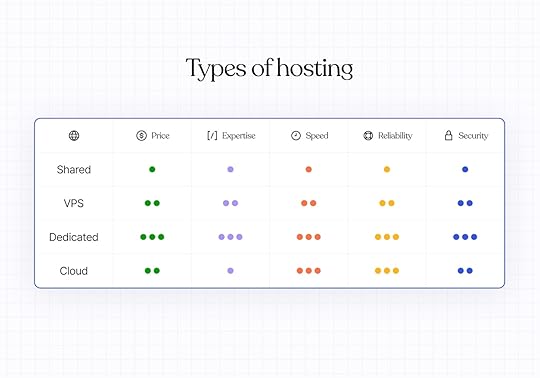 Shared hosting: the apartment experience
Shared hosting: the apartment experienceTypically for: Small websites, portfolios, personal blogs, and other projects with lower traffic and average security needs.
A shared host has many websites on a single server, and those websites must share resources like data storage, security features, and bandwidth. Shared hosting services usually impose hard limits on these to ensure everyone’s website has what they need.
Price: Since you’re splitting resources with other sites, shared hosting is often the most affordable server setup.Technical expertise: Shared servers are pre-configured and don’t require any technical know-how. Speed: Because you share hosting resources with other websites, your site can slow down if one of the sites on your server experiences heavy traffic. How the host configured your server can also impact your site speed.Reliability: Larger websites may run up against limits, causing slowdowns or server downtime for everyone on the server.Security: The host is responsible for adding security features to the server. You could be at risk if another website is not well secured.VPS hosting: the condoTypically for: Technical experts who want more control and mid-sized websites that are outgrowing shared hosting.
A VPS, or virtual private server, is the middle-ground between shared and dedicated servers (more on the latter next). With a VPS, your website lives on a private “virtual server” partitioned from other websites on a shared server. Virtual servers can typically be fully customized.
Price: VPS systems are generally more expensive than shared hosting.Technical expertise: Technical expertise is required to manage a VPS. That said, some managed hosts offer pre-configured VPS hosting.Speed: You can customize your virtual server to be optimized for your website. The virtual partition keeps other websites from using your allocated bandwidth. Reliability: VPS hosting offers more stability than shared hosting thanks to isolated resources. That said, since your virtual server still depends on physical hardware behind the scenes, issues with that hardware can cause downtime unless your host has strong redundancy or failover systems in place.Security: Since virtual servers offer greater isolation than shared hosting, they can be configured to behave like dedicated servers. However, security features aren’t applied automatically—you’ll need to configure and maintain them on your VPS.Dedicated hosting: the single-family homeTypically for: Large websites with high traffic, lots of data, or advanced security needs, including healthcare, finance, banking, and ecommerce sites.
Dedicated hosting means your website has a dedicated physical server, giving you complete control over every aspect of your setup and full access to your server’s resources.
Price: Since you’re renting an entire server for your website, this is generally the most expensive hosting option.Technical expertise: Dedicated hosting requires the most technical expertise to maintain the server. Some managed hosting providers offer dedicated hosting.Speed: Dedicated servers are fully customizable and don’t have to compete with other traffic. That means they are generally fast and reliable. Reliability: Dedicated servers can be configured for optimal reliability, but if the physical hardware experiences an issue, your site may still go down if the host doesn’t have strong redundancy or failover precautions.Security: Because yours is the only one on the server, dedicated servers can be the most secure (when properly configured).Cloud hosting: global vacation rentalsTypically for: Websites with variable spikes in traffic or websites that will grow quickly over time. WordPress.com’s Business plan and above are powered by WP Cloud, Automattic’s high-performance cloud infrastructure built specifically for WordPress.
Cloud hosting relies on a distributed network of servers in different locations. Cloud hosting can be a great option for sites that need high reliability because multiple server locations ensure redundancy and speed.
Price: Cloud hosting is, on average, cheaper than a dedicated server, but the prices can vary depending on your hosting provider and traffic. Technical expertise: Most cloud hosting is fully managed by the provider, meaning server maintenance, scaling, and infrastructure updates are handled for you. However, some cloud platforms offer more control and may require technical knowledge to configure or optimize your environment.Speed: Cloud hosting is typically fast thanks to a network of servers that can respond to geographically close requests. These solutions usually also include autoscaling, which automatically adjusts your site’s resources based on traffic. This keeps your site fast and stable during traffic spikes.Reliability: Because websites are hosted on a distributed server network, cloud hosting is extremely reliable; if one server goes down, another can jump in to meet the request.Security: Cloud servers use shared physical infrastructure, but virtualization keeps environments isolated. While generally secure, sites with sensitive data or regulatory requirements should evaluate the provider’s security protocols and certifications to ensure they align with the organization’s specific requirements.Hosting management: who manages your website?When evaluating web hosting options, consider how hands-on you want to be with your website’s setup and maintenance. Websites generally require regular updates for optimal performance and may require occasional reconfigurations to meet evolving marketing and optimization strategies.
For that reason, managed hosting, like what we offer at WordPress.com, is a popular choice for most websites, as managed hosts take care of much of the maintenance for you. If you use managed hosting, your provider determines your hosting infrastructure, so not all managed hosting services offer the same speed or reliability.
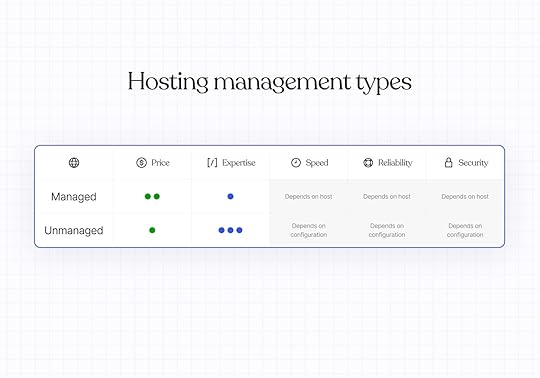 Managed hosting: Renting your digital home
Managed hosting: Renting your digital homeTypically for: Website owners who want their hosting managed by the pros.
Managed hosting is the most comprehensive solution, including host configuration, security, and infrastructure management. Managed hosting providers also take on your site maintenance, including automatic updates, security patches, and downtime response. WordPress.com is a managed hosting provider.
Price: Managed plans are typically more expensive because they handle your website configuration and maintain your website on your behalf. That said, prices do depend on your provider. Technical expertise: Server maintenance expertise is not required, as your managed host is responsible for optimizing and enhancing your server setup. You will still need to build your site yourself or with the help of a developer or an agency.Speed and reliability: Your managed provider’s server setup and site optimization strategies will impact your site speed and uptime. Be sure to look at these details carefully when choosing a provider.Security: Security features depend on your hosting provider but might include features like SSL certificates, backups, malware prevention, and protection from brute-force attacks.Get managed hosting through WordPress.comUnmanaged hosting: Owning your digital homeTypically for: Web developers and technically savvy teams who want full ownership and control over their hosting services.
Unmanaged hosting requires you to configure your own website on your server and manage the security and maintenance needs in-house.
Price: Unmanaged hosting tends to be less expensive because managing your site’s infrastructure isn’t included in your monthly or annual hosting costs. That said, because your host isn’t taking care of them for you, you may need to purchase add-on services for security and optimization.Technical expertise: You or someone on your team will need the skills to configure your website on a server and manage any issues that arise, including security threats or server problems that could take your site offline.Speed and reliability: Unmanaged hosting is extremely customizable, and your site’s performance depends on how your hosting is configured and your server type. Security: You are directly responsible for adding core security features and updating them as needed to ensure your site isn’t vulnerable to brute-force attacks, spam, or data breaches.What about reseller hosting?In your search, you may come across the term “reseller hosting.” This is not an infrastructure in and of itself, but rather a type of business where developers or small companies buy bulk server resources to resell to their clients. Resellers are responsible for configuring, maintaining, and protecting their clients’ websites.
Typically for: Companies or freelance website developers who want to create their own branded, managed hosting service for resale.
Price: You’re typically buying multiple hosting licenses at a discounted price so that you can resell them to your clients.Technical expertise: You are responsible for the technical configuration and maintenance of every site that purchases hosting services through your brand.Speed and reliability: As with unmanaged hosting, you are responsible for customizing and optimizing your servers to ensure good uptime and speed.Security: Like other unmanaged hosting types, you are directly responsible for the security features on the sites you manage.WordPress.com offers reseller hosting through WP Cloud.
 Why choose WordPress.com for managed hosting?
Why choose WordPress.com for managed hosting?If you’ve decided that managed WordPress hosting is the best solution for your needs, consider WordPress.com. From your first post to your millionth visitor, we ensure your site stays fast, secure, and online. We manage infrastructure, updates, backups, and security so users can focus on producing content and growing your business, not upkeep.
Flexible hosting for every stageOnly pay for what you need—no surprise costs, no upsells. From personal blogs to enterprise sites, our plans offer the performance, security, and features to match your site’s size and complexity.
Because WordPress.com websites use open source WordPress software, you own your website and data, and you can switch hosts and take your site with you at any time.
Use the most popular website builderWordPress remains the most popular website builder, powering over 43% of the internet. That’s because WordPress is open source, easy to use, and incredibly flexible.
WordPress.com’s hosting is specifically optimized for WordPress websites, meaning that we’ve done the work under the hood to ensure your WordPress.com-hosted site runs quickly and reliably.
Be techy (or not)Code or no code—we’ve got you. Developers get staging sites, custom code support, GitHub deployments, and bulk plugin management. Non-technical users get powerful traffic and social features with no configuration required.
Day-to-day website management done rightWe keep your site safe with automatic updates of your core WordPress software and all WordPress repository plugins and themes for performance and security. We also run daily scans to check every aspect of your site for malware, and automatic site backups are available on the Business plan and above.
Plus, if your site is ever hacked, we’ll fix it for free. We hope this never happens, but if it does, reach out to our support team.
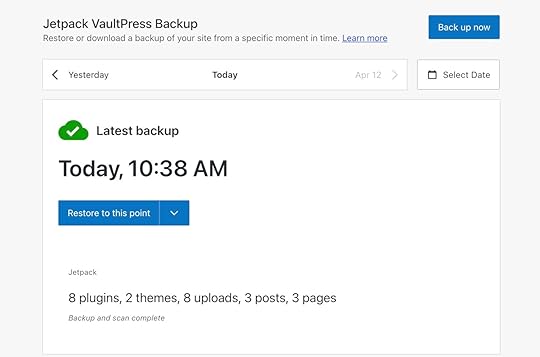 Lightning-fast and reliable websites at every level
Lightning-fast and reliable websites at every levelWordPress.com consistently has top-tier scores on third-party speed benchmark tests, outperforming many other hosting providers. Our model offers unmetered traffic and bandwidth on all plans, so you won’t need to worry about slower site speeds or extra fees once your site grows.
To give you incredible speed and uptime, we optimize your content and add performance-boosting tools like high-burst capacity, a content delivery network (CDN), and lazy-loaded images, which are included on all plans.
Top-notch security featuresAll WordPress.com websites come with comprehensive security features. SSL certificates with free domain privacy, brute-force protection, spam protection, DDoS protection and mitigation, malware detection and removal, web application firewall (WAF), and site activity logs protect your site from every angle.
Ready for managed WordPress hosting?Choosing the right hosting can feel overwhelming, but it doesn’t have to be. WordPress.com takes care of the heavy lifting from performance to security so you can focus on building your site, not maintaining it.
Get managed hostingApril 10, 2025
Ready for a Newsletter That’s Yours? Switch from Substack to WordPress.com
If you’ve been running a newsletter on Substack, you might be feeling some growing pains. Maybe you’re watching those 10% fees eat into your revenue as your subscriber base grows. Perhaps you’re hitting the limits of Substack’s customization options. Or you might be concerned about truly owning your content and audience data.
Whatever the reason for exploring alternatives, WordPress.com’s Newsletter feature offers a compelling alternative that addresses these concerns while providing a clear path for growth. And now, with our comprehensive import tools, migrating from Substack to WordPress.com is easier than ever.
Bring your newsletter to WordPress.comSeamlessly import your Substack content and subscribersWe’ve created a straightforward migration process that makes it easy to bring both your content and subscribers to WordPress.com.
Bring your existing posts with our importer tool. This tool preserves your entire publishing history, including images, formatting, and post metadata. Your archive remains intact, maintaining a connection with your audience and your SEO value.
You can also bring your subscribers—your most valuable asset—with you. Our subscriber import tool helps you import both free and paid subscribers, maintaining those crucial relationships you’ve worked so hard to build.
Why creators are moving from Substack to WordPress.comDid you know that every WordPress.com site comes ready to be a Newsletter? Even sites on our Free plan can email subscribers at no cost.
In fact, we’ve been sending newsletters since before they were called newsletters. We just updated the name to match what people call them today. While we both send newsletters, WordPress.com beats Substack in several crucial areas.
Keep more of what you earnOn Substack, a 10% fee for each transaction might seem reasonable when you’re just starting out. But as your newsletter grows, that money really adds up.
With the WordPress.com Commerce plan, we don’t charge a fee for each transaction. That means if you have 100 subscribers paying $10 per month, you’d save $660 per year.
Plus, with WordPress.com plans, you also get reliable and managed website hosting, built-in support, and essential audience-building tools—all for one predictable price.
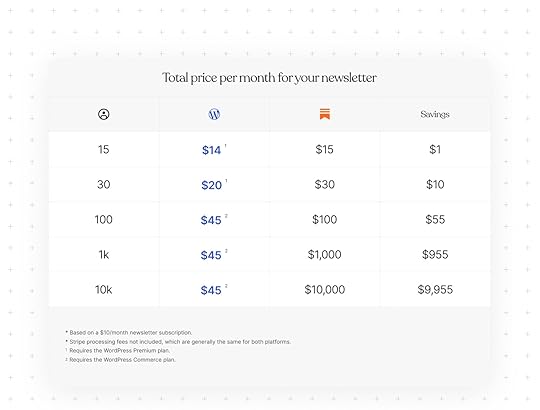
If 1,000 subscribers pay $10 per month each for your newsletter, Substack would charge $1,000 per month in transaction fees, based on their current fee structures.
By hosting your newsletter on WordPress.com, you’d save $955 per month.
Your subscribers are paying for your content, right? Why shouldn’t you get that money?
Don’t fit in; stand outSubstack’s design options are limited, so creating a distinct brand identity can be challenging.


WordPress.com gives you more ways to customize your newsletter site with:
Dozens of professionally designed themes specifically optimized for newsletters.Complete customization of colors, fonts, and layouts.The ability to create a distinctive visual identity that reinforces your brand.Custom landing pages that convert visitors to subscribers. Break through the newsletter ceiling
Break through the newsletter ceilingWhat if you’re ready to expand beyond newsletters? WordPress.com enables you to:
Own your piece of the web: Show up like an established business with a full-featured website.Sell products and services: Add an ecommerce store to your site to sell merchandise, digital products, or services.Build a loyal following: Create membership communities with forums and exclusive content.Target your audience: Develop custom landing pages for different audience segments.Expand what your site can do: Integrate with other tools and services through our plugin ecosystem.Truly own your content and dataSubstack gives you access to your content and subscribers, but you still rely on a closed platform with its own policies and limitations that can change at any time.
WordPress.com gives you full control over your site, your data, and how you grow your business. If something were to change with our service, you could simply move to another WordPress hosting provider. Twenty years of commitment to content ownership and the open web ensures you’re not locked into proprietary systems.
We allow you to export your content and subscriber data anytime, control your brand, content, and relationships with your audience, and build on WordPress, the open-source platform that powers over 43% of the web.
Ready to make the move?Whether you’re looking for more design flexibility, vastly lower fees, or true content ownership, WordPress.com provides a robust alternative to Substack. Join the thousands of creators who have chosen WordPress.com as their newsletter platform.
Move to WordPress.comApril 9, 2025
Just Say the Word—Try Our New AI Website Builder for Free
Imagine this: You have an idea—maybe it’s a side hustle, a passion project, or a bold new business. Instead of wrestling with site layouts and design choices, you just say the word…and your website appears.
Creating a website should be simple. And now it’s as simple as having a conversation.
That’s the magic of our new AI website builder. It takes your input and instantly creates a fully designed, content-ready WordPress website, complete with text, layouts, and images, for you. Just you and your vision, with AI handling the rest.
Build your site with AIWho is it for?Our AI website builder is ideal for anyone who wants to launch a great-looking website quickly and easily, including:
Entrepreneurs and small business owners who need a professional online presence without building it all from scratch.Freelancers and creators who want a portfolio that looks great with little effort.Bloggers and side hustlers who want to quickly share their ideas online.Developers who want to spin up ideas quickly for clients without starting from zero.While it isn’t quite ready to create ecommerce sites or sites that require complex integrations (but stay tuned!), the builder will create beautiful, functional websites in minutes.
How it worksRather than piecing everything together yourself, like picking a theme, adjusting colors, adding text, and finding images, the builder streamlines the process for you:
Head to this page and tell us about your website idea.Log into your existing WordPress.com account or sign up for free.Watch AI build your site.Make changes by manually editing the page or by asking for updates in the chat box.Ready to share your site with others? A WordPress.com hosting plan gives your AI-built site a secure, reliable home online with a free domain for the first year. Then you can go live when the timing is right, or click the Launch button in the top-right corner to launch immediately.Use the AI website builder like a proUnlike other AI experiences that generate basic, one-size-fits-all templates, our AI website builder does things differently. Here are a few key tips to keep in mind when you use it:
Be as specific as possible in your first prompt: The more information you supply to the builder, the better. Provide your desired site name and a short description of the site (Is it a portfolio site, blog, or business website? What kind of content will you publish on the site?). Remember that you’ll be able to tweak colors, fonts, layouts, and images later, so don’t stress about this step too much!Create a new site to use the builder: This feature is currently only available for brand-new WordPress.com websites.Get 30 free prompts: Want a new page? What about a contact form? How about a new picture for your homepage? Take advantage of your 30 free prompts (or purchase a hosting plan for your site to get unlimited prompts) to create a site that’s uniquely yours. Return anytime: Want to take a break? Once you have a hosting plan, you can return to using the AI website builder by going to Appearance → Editor in your WordPress.com site dashboard whenever inspiration strikes.It’s still WordPress: If you want to take over, you can edit and add pages manually, change the site design, and use development tools on our Business plan and above. Learn more: Dive deeper into using the builder by checking out our support documentation. Get started todayYou need a website, not a new skill set. Instead of figuring out how to build a website from scratch, you can have a full-blown WordPress site that looks great and works seamlessly without the manual effort.
Get online fast, and start running your business, sharing your ideas, or having a place to call your own on the web.
Our AI website builder is live (and free) today—what will you build with it?
Build your site with AIApril 8, 2025
What is a WordPress Sitemap and How Do You Add One to Your Site?
A WordPress sitemap is a file that lists all of the posts, pages, and other content that make up a site.
Although sitemaps are usually created by WordPress by default, this isn’t always true. In this guide, we cover how to check if your site has one and what to do if it doesn’t. We’ll also explore the differences between XML and HTML sitemaps.
What exactly is a sitemap?When people talk about sitemaps, they’re usually referring to an XML sitemap. While there are other types, let’s start with XML.
An XML sitemap gives search engines a comprehensive overview of your site’s structure. It typically includes the full URL of each page and notes the last time each one was updated.

XML sitemaps exist primarily to help search engines find all the pages and other content on your site. This allows the search engine to add your content to its index and, when relevant, show it to users in search results.
Although search engines can index your pages without a sitemap, having one helps them do so more efficiently.
Due to this, having a WordPress XML sitemap is highly recommended.
Other types of sitemapsWhile XML sitemaps are the most common types of sitemaps, they aren’t the only kind of sitemap you might want to use on your site. Depending on your audience and the content, adding other types of sitemaps can improve navigation and visibility.
HTML sitemapsYou now know that search engines use XML sitemaps, but human visitors can also use sitemaps called “HTML sitemaps.”
HTML sitemaps are often used when a site has many pages and adding links to all of those pages in the site’s navigation menu would be overwhelming.
Unlike XML sitemaps, HTML sitemaps have no strict format; you can design them as freely as regular pages.
If you’re hosting your site with WordPress.com, you can use the sitemap shortcode to quickly create an HTML sitemap. The shortcode generates an ordered list of all the pages on your site, highlighting parent/child relationships based on your page settings.
To create an HTML sitemap on your WordPress.com-hosted site:
Visit your site dashboard and create a new page (Pages → Add Page) or edit an existing one (Pages → All Pages → Edit).Add a Shortcode block to the page by clicking the + symbol and typing shortcode.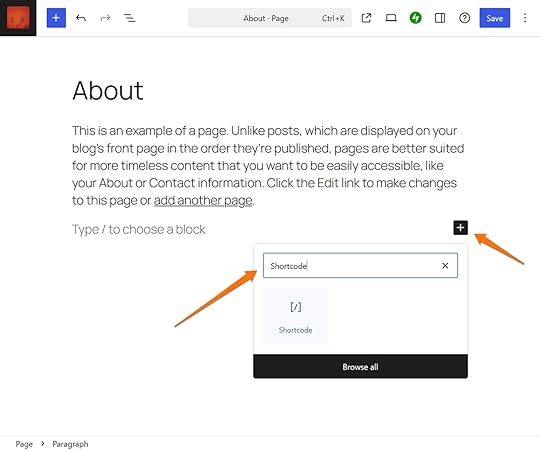 Type sitemap in the Shortcode block field surrounded by brackets.
Type sitemap in the Shortcode block field surrounded by brackets.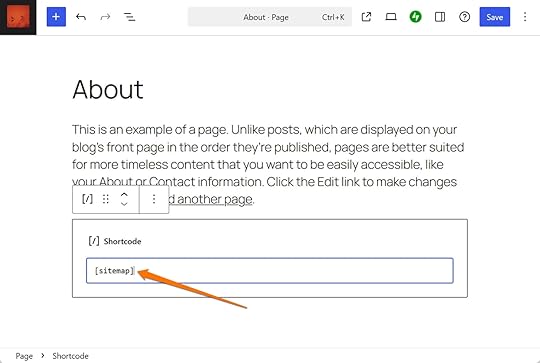 WordPress.com News
Comment Guidelines for the WordPress.com News Blog' in the Shortcode block" class="wp-image-78739" srcset="https://en-blog.files.wordpress.com/2... 1400w, https://en-blog.files.wordpress.com/2... 150w, https://en-blog.files.wordpress.com/2... 300w, https://en-blog.files.wordpress.com/2... 768w, https://en-blog.files.wordpress.com/2... 1024w" sizes="(max-width: 1400px) 100vw, 1400px" />Preview or publish the page to view the shortcode output.
WordPress.com News
Comment Guidelines for the WordPress.com News Blog' in the Shortcode block" class="wp-image-78739" srcset="https://en-blog.files.wordpress.com/2... 1400w, https://en-blog.files.wordpress.com/2... 150w, https://en-blog.files.wordpress.com/2... 300w, https://en-blog.files.wordpress.com/2... 768w, https://en-blog.files.wordpress.com/2... 1024w" sizes="(max-width: 1400px) 100vw, 1400px" />Preview or publish the page to view the shortcode output.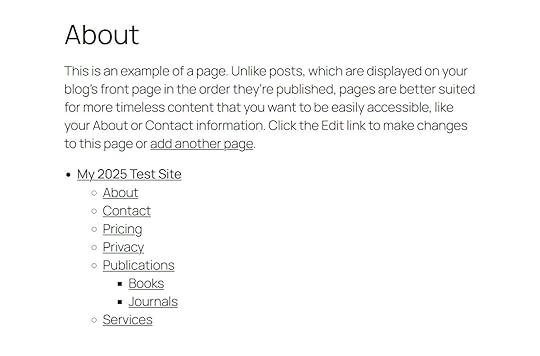
If your site isn’t hosted by WordPress.com, you can add a similar HTML sitemap by using a plugin like Simple Sitemap.
Other types of XML sitemapsThere are also different types of XML sitemaps.
While the standard WordPress XML sitemap lists a site’s posts and pages, there are also XML sitemaps for listing a site’s images and videos. These sitemaps can help search engines add your images to places like Google Images.
There’s also the news sitemap, which is required for websites listed in Google News. This type of sitemap helps Google News quickly add fresh news content to its index.
WordPress.com-hosted sites automatically generate a news sitemap; however, inclusion in Google News requires approval.
Understanding your WordPress sitemapSince version 5.5 (released in 2020), WordPress core has the functionality to automatically generate XML sitemaps. The WordPress sitemap is updated each time you publish or edit content.
Viewing your WordPress XML sitemapTo view your WordPress XML sitemap, add sitemap.xml to the end of your site’s domain name in the URL field of a browser window.
If you see an error message stating that the page cannot be found, your site probably doesn’t have a sitemap.
If your site does have a sitemap, you’ll see something similar to the one below. The exact format will depend on how the sitemap was generated.
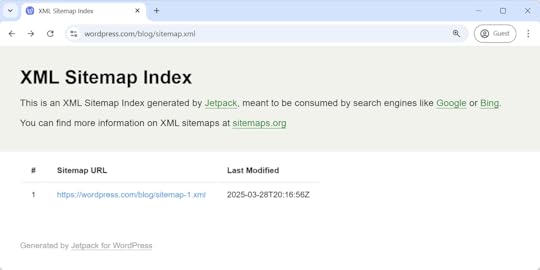
You can view the sitemap’s contents by clicking on any URL.
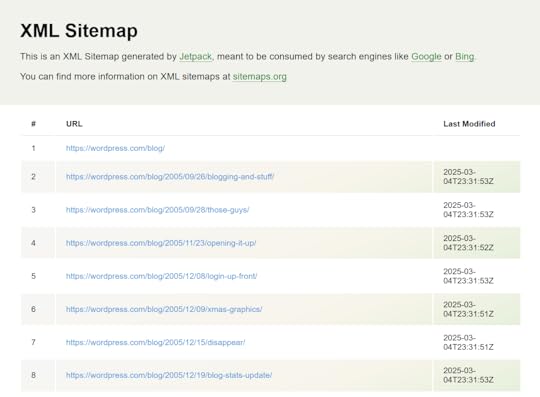
If you can’t see a sitemap for your WordPress.com site, then you can follow these steps to check the settings that could be causing the issue:
Visit your site’s dashboard.Navigate to Tools → Marketing.Click the Traffic tab.Scroll down to the Sitemaps section.If sitemaps are enabled, you should see them listed.
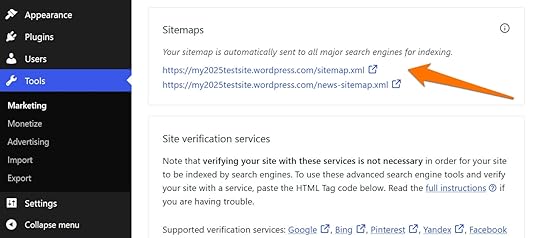
If you see “Your site is not currently accessible to search engines,” click the “privacy settings” link to fix it.
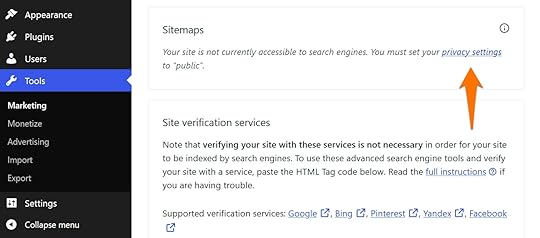
From the Privacy Settings page, uncheck the “Discourage search engines from indexing this site” box, then click the Save button.
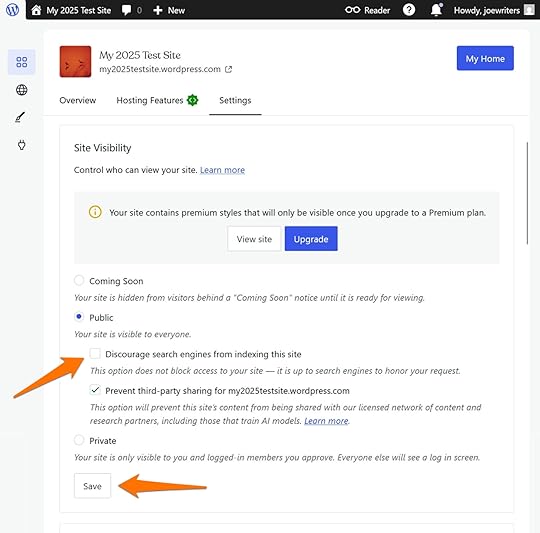
If you return to the Traffic tab (Your site dashboard → Tools → Marketing), you should now see your sitemap URL(s).
If WordPress.com isn’t your web host, then the process for enabling a WordPress sitemap is very similar:
Visit your site’s dashboard.Navigate to Settings → Reading.Uncheck the “Search engine visibility Discourage search engines from indexing this site” box.Click the Save Changes button.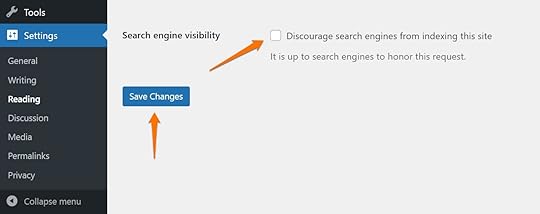 Enter [your site URL]/sitemap.xml in your browser address field to check the sitemap status.
Enter [your site URL]/sitemap.xml in your browser address field to check the sitemap status. If you still can’t see a sitemap, a third-party plugin might be managing your sitemap instead. You can access your site dashboard and click Plugins from the sidebar menu to check this.
The plugins page shows any installed (activated or deactivated) plugins on your site. Many plugins have added sitemap functionality, but some popular ones are Jetpack, Yoast SEO, Rank Math SEO, and XML Sitemap Generator for Google.
If a plugin with sitemap functionality is active on your site, check its settings to see if it has disabled the sitemap.
For example, you can access the Jetpack plugin’s sitemap settings by navigating to Jetpack → Settings and clicking the Traffic tab.
You can then toggle the Generate XML sitemaps setting.
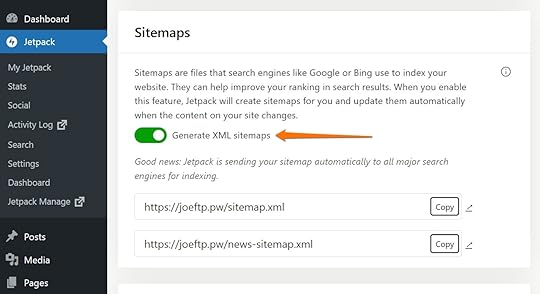 Submitting your XML sitemap to search engines
Submitting your XML sitemap to search enginesAs the purpose of a WordPress XML sitemap is to help search engines find your pages, you might wonder if you need to do anything to let the search engines know about your sitemap.
Thankfully, you typically don’t have to worry about this. Search engines like Google and Bing regularly crawl the web, following links from one site to another. If your site is publicly accessible and linked to from other places, search engines will likely discover your sitemap automatically. Most websites include a link to their sitemap in the site’s robots.txt file, which search engines check by default. This usually helps them to find and use your sitemap without any manual submission.
However, if you’d like to speed up the process, you can manually submit your sitemap to Google and Bing to ensure they can crawl your site.
Submit your XML sitemap to GoogleYou can submit your WordPress XML sitemap to Google through Google Search Console.
Google Search Console is free to use, but you’ll need a Google account to use it. You’ll have to connect your site to Google Search Console—once you have, you can add your WordPress sitemap.
To do so, click Sitemaps from the Google Search Console’s sidebar menu.
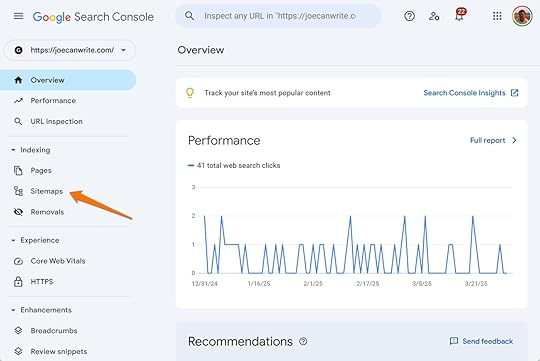
You can then enter the sitemap name, which should be sitemap.xml (note that if a third-party plugin generated your sitemap, then it might be named differently), and click the Submit button.

The sitemap will then appear in the “Submitted sitemaps” panel.
Submit your XML sitemap to BingYou can also submit your XML sitemap to Bing through Bing Webmaster Tools.
You should be able to log into Bing Webmaster Tools using your Google account and verify your site using the data from Google Search Console. Once done, you can add your sitemap by clicking on Sitemaps on the sidebar menu.

The data import from Google Search Console should have added your sitemap, but if not, click Submit sitemap in the top right corner.
Then, enter your sitemap URL, like [your site URL]/sitemap.xml, and click Submit to add your sitemap to the list.
How to check if your sitemap is working properlyOnce you’ve submitted your sitemap, you can verify that it’s working as expected. A broken or incomplete sitemap can prevent search engines from indexing your content correctly.
Use Google Search Console: Once you’ve submitted your sitemap through Google Search Console, you can view its status in the “Sitemaps” section. It will show when the sitemap was last read, how many URLs were indexed, and if there are any crawl or parsing errors.Check Bing Webmaster Tools: Bing provides similar feedback in its “Sitemaps” report—you can see any errors or warnings here.Use other third-party validators: If you want to double-check the technical structure of your sitemap, you can use free online tools like the Sitemap Test from SEO Site Checkup. Help search engines—and your visitors—find your WordPress siteA WordPress XML sitemap isn’t mandatory, but it gives your site important benefits that ensure your content gets in front of the right people.
Once your WordPress site has a sitemap, search engines like Google and Bing will find it easier to crawl your site and add its content to their indexes. And with more of your content available in the search engine indexes, more search engine users will be able to find your site.
While WordPress creates XML sitemaps by default, it is highly recommended that you follow the steps in this guide to see if your site has one. If it doesn’t, you can check the relevant settings outlined above to fix any issues.
WordPress.com makes ensuring that your site content is indexable by search engines easy because we automatically generate an XML sitemap for you. Host your site with WordPress.com and get hosting, performance, and security managed for you all in one place.
Host with WordPress.comApril 7, 2025
What is cPanel (& Why Doesn’t WordPress.com Use It)?
If you’re a WordPress developer, you’ve probably run into cPanel before. It’s so common on traditional hosting platforms that, for many developers, it’s the default control panel they expect to see. When you sign up for a managed hosting provider like WordPress.com and don’t find it, it might feel like something important is missing.
But that expectation is part of a common myth that WordPress.com isn’t developer-friendly because it doesn’t use cPanel. The truth is that WordPress.com gives you all the development tools you need without the outdated interface and extra clutter.
This article will explain what that means by covering cPanel and its uses, why it’s not used on WordPress.com, what we offer instead, and why you might even prefer our solution.
Intrigued? Let’s jump in.
What is cPanel?cPanel is a hosting control panel used by many web hosts, especially shared providers, and it offers a browser-based graphical interface to manage various aspects of your website and hosting.
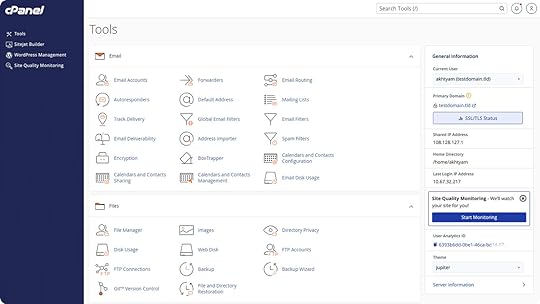 Image from cPanel.net
Image from cPanel.netIt was originally designed to make hosting more accessible to non-technical users by allowing them to perform server tasks that usually require expert knowledge. Over time, cPanel has also become a standard tool for developers because of its wide adoption and broad functionality.
cPanel is a popular management software that allows you to:
Manage website files via the file manager Create and manage FTP (file transfer protocol) accounts.Create and manage MySQL databases.Set up , subdomains, and DNS (domain name system) records.Create and manage email accounts tied to your domain.Install CMS (content management system) platforms like WordPress using one-click installers.Manage backups, SSL (secure sockets layer) certificates, and server usage statistics.Connect your site to a CDN (content delivery network).It’s important to note that cPanel is a third-party program independent from your website. You must log in to it separately, usually through an address like https://example.com:2083, using a separate username and password.
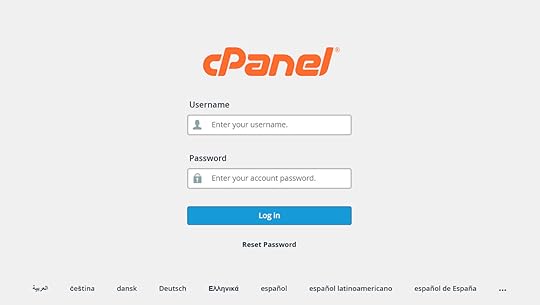
In addition, cPanel is proprietary software, which means hosting providers pay licensing fees to use it. This can affect your hosting costs. Hosts often customize the available features and styling of their cPanel installation, which is why it can look different from one hosting provider to another.
If you have never worked with the hosting panel before, you can try it out using the official cPanel demo.
Why doesn’t WordPress.com use cPanel?You may have heard that WordPress.com is “limited” because it doesn’t come with cPanel, but this perception often comes from developers who are simply used to finding the control panel on shared hosting platforms. In reality, WordPress.com doesn’t lack features; it simply takes a different, more streamlined approach.
Instead of using a third-party tool like cPanel, WordPress.com has a purpose-built control panel on our Business and Commerce plans designed specifically for WordPress hosting and development. It offers direct access to the features developers actually need and use (more on those in a minute) in a cleaner, more integrated interface.
This means you don’t have to switch to an external application to modify necessary server settings, and you have all the control you need without the extra clutter.
What hosting features does WordPress.com offer?In addition to fast, secure hosting with unlimited visitors and unmetered bandwidth, our Business and Commerce plans offer plenty of developer features. They’re located in the Sites menu under Settings.
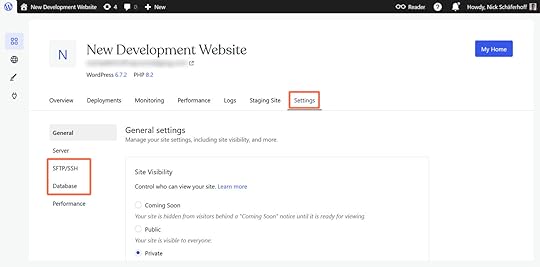 SSH
SSHSSH (secure shell access) allows you to interact with your site’s environment via the command line. For example, you can run WP-CLI commands, manage and edit plugin and theme files, and troubleshoot site issues.
On WordPress.com, you create your SSH credentials in the aforementioned site settings under the SFTP/SSH tab.
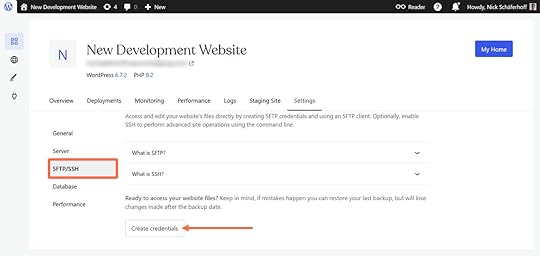
Click the button to access the URL, port, username, and password for the SSH and SFTP connections.
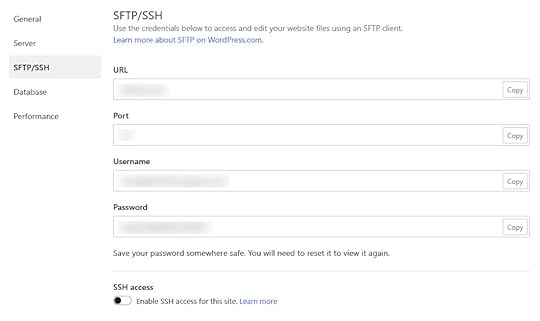
You’ll also need to switch on SSH access for your site separately at the bottom.

This also gives you the option to generate an SSH key to make it even easier to connect to your sites. Our full SSH documentation provides information on that and available shell commands.
SFTPWordPress supports the secure file transfer protocol (SFTP) to connect directly to your site’s server. SFTP gives you full access to themes, plugins, and media uploads so you can deploy custom code or make manual changes to files.
Create your credentials as directed above and simply copy and paste them into your favorite FTP client, such as FileZilla or Cyberduck.
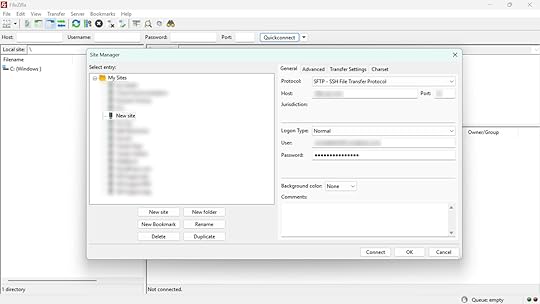
For additional details, see our SFTP documentation. To ensure optimal performance and security, WordPress.com restricts certain plugins, and some are fully incompatible and can’t be activated (even if uploaded via SFTP). If you need a specific plugin, feel free to contact us—we’re happy to suggest alternatives.
Database accessOn WordPress.com, you can access your site’s database via phpMyAdmin. Just click the Open phpMyAdmin button in the Database tab under the site settings.
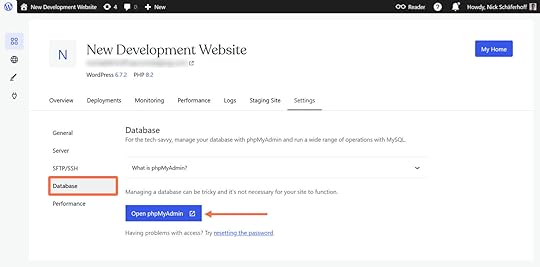
This automatically logs you in and lets you view and edit your database tables, debug issues, or customize data.
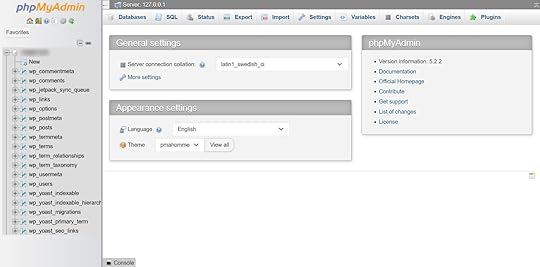
You’ll find all of the familiar phpMyAdmin features here, including importing SQL files. For extra security, you can test your SQL commands on a staging site, and if something still goes wrong, you can easily restore your site from backup.
More information is available in our database access documentation.
No cPanel, no problemMany developers start with cPanel because it’s standard, but it isn’t the only (or the best) way to manage a WordPress site.
On WordPress.com, you benefit from a cleaner, faster, and more efficient experience integrated directly into your main site dashboard. With only the most relevant features, we help you streamline your build process for any type of website.
When you build a site on WordPress.com, you benefit from:
Automated burst scaling to handle traffic spikes.99.999% uptime and real-time replication to secondary data centers.Automatic image compression and management.A global edge cache and CDN, with 28+ data centers across six continents.Built-in DDoS protection, a WAF, and proactive threat monitoring.Automatic core updates, backups, and malware scanning.Developer-focused support from WordPress.com’s expert team.Build your sites on WordPress.com, and if you’re looking for a free, open source, and lightweight local development tool, we’ve got you covered with Studio.
Get WordPress.com hostingMarch 31, 2025
Add Custom Domains and HTTPS Support to Your Local WordPress Development with Studio
WordPress Studio continues to evolve with features that make local WordPress development more powerful and flexible. In Studio version 1.3.9, you now have custom domains and HTTPS (SSL) support.
As a reminder, Studio is our free and open source local development environment. It’s a powerful, lightweight tool that enables straightforward workflows for both extending and building WordPress sites.
Download StudioWhy custom domains and HTTPS matterWhen developing WordPress sites, you often need to replicate the production environment as closely as possible. Many WordPress plugins and themes require specific domain names or HTTPS to function correctly. Previously, accessing your local WordPress sites in Studio meant using localhost with port numbers, which could limit your testing capabilities.
With custom domains and HTTPS support, you can now:
Assign custom domain names (e.g., my-blissful-website.wp.local) to your local Studio sites.Test features that require proper domain names.Develop with SSL/HTTPS enabled.Create a more production-like environment locally.How it worksThe implementation is designed to be as seamless as possible, with Studio handling nearly all of the technical details in the background.
To enable these features in Studio:
Create a new site or edit an existing site using the “Edit site” button on the “Settings” tab.If creating a new site, toggle “Advanced settings” in the modal that appears.Enable the “Use custom domain” option.Choose a domain name with the .local TLD (e.g., my-blissful-website.wp.local).Optionally, check the “Enable HTTPS” option for secure connections.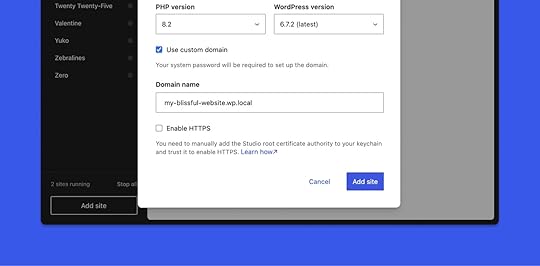 Click the “Add site” or Save button, depending on whether you are creating a new site or editing an existing one. When prompted, permit Studio to modify the system hosts file. Studio will configure everything else automatically. For HTTPS connections, a root certificate authority will be generated and installed. On macOS, you’ll need to manually install the certificate to avoid browser warnings. Refer to the documentation for more details.Navigate to your site using the custom domain.What’s next for Studio
Click the “Add site” or Save button, depending on whether you are creating a new site or editing an existing one. When prompted, permit Studio to modify the system hosts file. Studio will configure everything else automatically. For HTTPS connections, a root certificate authority will be generated and installed. On macOS, you’ll need to manually install the certificate to avoid browser warnings. Refer to the documentation for more details.Navigate to your site using the custom domain.What’s next for StudioAt WordPress.com, we’re constantly fielding your feedback and iterating to make Studio the best local development environment for WordPress sites. Custom domains and HTTPS are just some of the many features we’re adding based on your needs and feedback.
Have more feedback to share with us? Open an issue in GitHub.
Download Studio today to start developing locally, and subscribe to our developer newsletter, Dev & Deploy, to stay in the loop on all things Studio.
Build with StudioMarch 27, 2025
Improved Control for Your Newsletter with Categories and Subscriber Management
We’ve been busy developing new features that make creating, managing, and growing your newsletter through WordPress.com easier. These features give you more control and better insights into your audience.
As a reminder, every WordPress.com site includes Newsletter, granting you the ability to send new posts via email to subscribers. If you already have a site on WordPress.com, simply add a Subscribe block or one of our Newsletter Subscription patterns to your site. Readers who subscribe by email will be notified whenever you publish new posts.
If you don’t already have a WordPress.com site, you can still use Newsletter. You can email up to 100 subscribers for free. Need more? Upgrade to a paid plan to import unlimited subscribers, use premium designs, and get detailed email analytics.
Start your newsletterSend your subscribers exactly what they want with categoriesOne of our most requested features is here! With categories, you can now organize your topics and let subscribers choose the kind of content they want to receive.

Categories unlock plenty of opportunities for your newsletter:
Segment your content: Create different categories for your various content types (e.g., “Product talk,” “Photography,” or “Lunch”). Give power to your readers: Subscribers can select which categories interest them most, so they only get the content they’re most likely to engage with.Set preferred categories: Apply default categories on subscription forms to highlight specific content types for your readers.Import and export with just a click: If you already have subscribers with categories elsewhere, it’s easier to import them. Ready to move on? You can easily export them and take them with you.Enable categories today on your Newsletter Settings page.
Deeply understand your subscribers with Data ViewsManaging your audience just got a significant upgrade with Data Views.

You’ll love Data Views because of its detailed insights about your subscribers. There are three main ways to use this new feature:
Filter and sort by subscription type: Where are your subscribers seeing your content? Find out if they’re subscribed via email or the Reader and whether they’re free or paid subscribers. Quick preview: Do you need to know exactly who your subscribers are? With Data Views, you can open a convenient side panel to view complete subscriber information.Dig into the details: If certain subscribers aren’t receiving your emails, you can quickly identify whether they still need to confirm their subscription or if their email address can’t receive messages.To manage your subscribers, navigate to Users → Subscribers. If you’re using Jetpack, go to Jetpack → Subscribers.
Newsletter management on your DashboardWe’ve centralized Newsletter management with a new WordPress.com Dashboard widget, providing you a quick overview of your Newsletter’s performance.
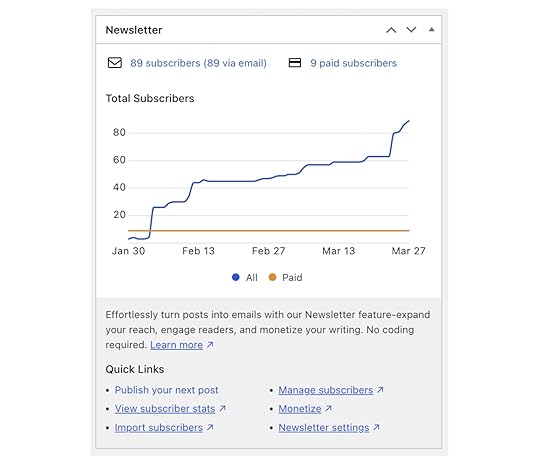
As soon as you log into WordPress.com, you’ll now see:
Subscriber counts: View your email and paid subscriber counts at a glance.Trends: Track recent subscriber growth with an intuitive line chart.Quick links: Access important Newsletter features with one click.Import capability: Easily import subscribers directly from the widget.Check out the widget on your Dashboard.
Newsletter from anywhere with the Jetpack appThe latest updates to our subscriber management tools are fully optimized for mobile devices through the Jetpack app. Now you can:
Watch your email list grow: Track subscriber growth and your newsletter performance from anywhere, right from your phone.Get real-time updates: See when someone comments on a post or when you get a new subscriber while you’re on-the-go.Publish and comment from anywhere: Write, edit, and keep the conversation going, even when you’re away from your desk.Expand your audience: Your newsletter will appear in the WordPress.com Reader, expanding your audience even more.Download the Jetpack mobile app today on Android and Apple devices.
What’s next?We’re constantly improving Newsletter, and more exciting updates are on the horizon. Your feedback drives our development, so please share your thoughts and suggestions in the comments below.
With WordPress.com’s Newsletter, you can maintain complete ownership of your content and subscriber lists, add paid subscriptions on any plan, and keep more of your subscriber revenue.
Ready to send? Get started with a new site or add Newsletter to your existing site.
Start your newsletterMarch 26, 2025
25 Types of Websites You Can Create With WordPress
One of the biggest misconceptions about WordPress, the software powering WordPress.com, is that it can only be used for certain types of websites. Many people still see it mainly as a blogging platform or a solution for hobby websites.
There are reasons for that. For one, WordPress originally started as a blogging tool and is still one of the most popular programs to blog with. Second, because WordPress is open source, some assume that free software couldn’t possibly match—let alone outperform—paid, proprietary tools.
That view no longer reflects what WordPress is capable of today. WordPress has outgrown its humble beginnings and is now powering more than 43% of the entire internet—including websites of all different kinds and sizes.
To help you better understand the possibilities WordPress offers, here are 25 types of websites you can build with it right now, as well as the features, tools, and extensions that help you create them more easily.
Personal and hobbyist sitesWordPress has grown far beyond its roots—but it’s still a great choice for personal and hobbyist websites.
1. Portfolio websiteThe goal of a portfolio website is to share your creative work, like your photography, design, writing, or art. As a creator, an online portfolio allows you to highlight your skills, expertise, projects, and clients you’ve worked with.
This kind of site is great for helping you build a personal brand and attract potential clients and employers. Plus, a portfolio website builds visibility in search engines and makes it easy to share your work.
If your goal is to create this type of website, WordPress.com offers a variety of dedicated portfolio themes.
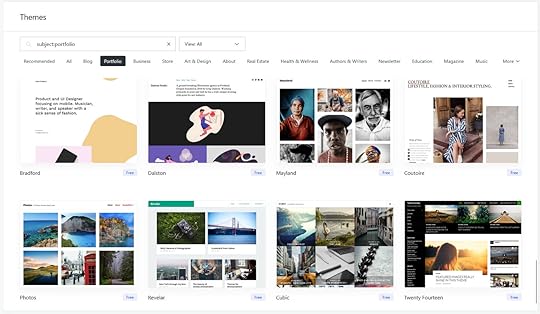
In addition, the WordPress editor makes it easy to display videos, images, and other content types. You can assign a separate portfolio category and show all your work on one page, and use the Form block to give potential collaborators an easy way to get in touch.
Finally, on the Business plan and above, you can further enhance your portfolio site with plugins.
2. Resume websiteA resume website is exactly what it sounds like—your job resume in website form.
Creating a resume website helps you stand out from other applicants and lets you showcase your job experience and skills in a more engaging way, and building your own website is a good way to demonstrate technical skills and initiative.
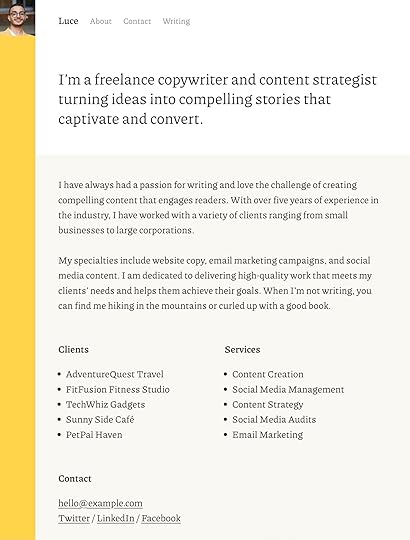 The Luce theme
The Luce themeAn online resume allows for more distinct branding than resumes in paper form, and it enables you to showcase additional information, like testimonials or endorsements from previous employers. Plus, by optimizing your site for search engines, you become visible outside of traditional recruiting channels.
On WordPress.com, themes like Luce can help you get started.
3. Personal websiteWith your personal website, you can:
Share your interests, hobbies, or experiences.Establish an outlet for writing, photography, or other creative pursuits.Communicate your knowledge, opinions, or thoughts.Showcase your skills or side projects.Build an online presence beyond social media.If you want your own, we have a detailed guide for how to build a personal website. It covers everything from picking the right theme to using the website builder and adding the right plugins for your personal website.
 The Kawaii-Chan theme4. Link-in-bio site
The Kawaii-Chan theme4. Link-in-bio siteThese types of websites have become especially popular among social media influencers since social platforms often limit the number of links you can display in your profile. Link-in-bio sites let you consolidate all of your important links on one simple page.
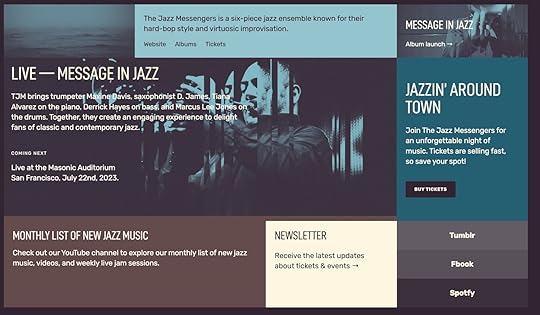 The JazzyGrid theme
The JazzyGrid themeDoing so helps you drive traffic to a blog, store, or other online platform and makes updating links easier because you only need to do it in one spot. You can also use your own branding, use a custom domain, and track clicks and engagement.
WordPress.com has a wide selection of themes and plugins for link-in-bio sites.
Publisher websitesWith a mission to “democratize publishing,” it’s no surprise that WordPress is an excellent tool for building several types of content-based websites.
5. BlogA blog can be personal or part of a business website (like the one you’re reading now), and it lets you share many kinds of content like:
NewsOpinionsProduct updatesPersonal thoughts and storiesRecipes The Memphoria theme
The Memphoria themeBlogging is great for building an audience, generating organic traffic, improving your writing skills, establishing credibility in an industry, and creating a community around shared interests. You can also monetize your blog through things like ads, paid newsletters, and sponsored content.
WordPress is an excellent platform for starting a blog, featuring essential tools for creating and managing multimedia content, a variety of blogging themes, and countless plugins.
When you host your blog on WordPress.com, you can additionally build an audience and drive traffic through The Reader.
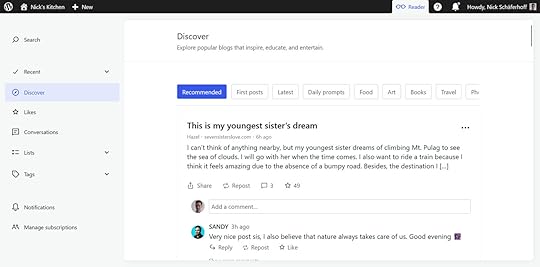
Refer to our posts on starting a successful blog and increasing blog traffic for more guidance on starting an excellent blog.
6. News websiteThe goal of a news website is to provide up-to-date information on current events, trends, or niche industries. You can use it to cover everything from world news to local events.
Running a news website is a great way to advance a hobby, a cause, or an interest and shine a light on important issues. You can also use it to build authority or monetize through advertising, subscriptions, or sponsorships.
The same features that make WordPress an excellent platform for blogging also make it a smart choice for news sites:
Built-in functionality to write, publish, manage, and organize contentA vast selection of themes and plugins, particularly for customizing a newsfeedNative support for multiple authors, making collaboration easyScalability that keeps your site fast and reliable—even when traffic surges or an article takes offTip: All WordPress.com plans include unlimited bandwidth and no cap on visitors, so your site stays stable no matter how much attention it gets.
7. Magazine websiteWhere news sites deliver timely updates, magazine websites lean into long-form content, interviews, and feature stories. They allow you to cover any topic, from fashion and celebrity gossip to homemaking.
WordPress is a great choice to build these types of websites because it supports multimedia content out of the box, including podcast and video embeds. There are also plenty of magazine themes for a professional and organized look.
 The Spiel theme8. Podcast website
The Spiel theme8. Podcast websiteEven though podcasts can be hosted on streaming platforms, they still benefit from a dedicated web space.
A website provides a home base where listeners can subscribe to your show and stream your episodes. It also gives you the opportunity to offer additional context and content like show notes, transcripts, links, and sponsor information. You can also use a podcast website to build an email list for a newsletter or show updates.
On WordPress.com, podcast themes and the Podcast Player block let you build a site that looks and feels professional.
 The CastCore theme
The CastCore themeYou may also embed episodes from popular streaming platforms, including Spotify and YouTube.
9. Video streaming websiteYouTube and TikTok are a testament to the popularity of video content. Using WordPress.com, you can create a video streaming platform and showcase original content.
You can use these sites to showcase your portfolio as a filmmaker, videographer, or video creator, build a community around specific topical areas, and offer exclusive or paid videos to subscribers.
With WordPress auto-embeds, you can display content from different streaming platforms. Simply copy and paste a link into the editor—the rest happens automatically. On WordPress.com’s Premium plan and above, you can also use VideoPress to host your videos instead of third-party solutions.
Commercial SitesWordPress is also a solid choice if your site has a commercial focus—whether you’re selling products, services, or something in between.
10. Business/company websiteA business website is an important tool for establishing credibility and online visibility, and it provides potential customers with information about your products or services.
 The Shore theme
The Shore themeCommon information and features of business websites include:
Contact options and business hoursA map showing your locationsFAQs or knowledge basesCompany news and helpful blog contentOnline shopping and appointment bookingLead generation, like an email newsletterOn WordPress.com, you can find a selection of themes for business sites that can give your site a professional style.
In addition, there are plugins for business site needs, like integrating your site with CRMs, email marketing platforms, and marketing automation tools.
What’s more, built-in SEO capabilities on the WordPress.com Business plan and above make it easy to optimize your site for search and attract new customers. You can further enhance them with SEO plugins.
11. Ecommerce website (online store)Online shops are a popular way for businesses to monetize, as you can sell products (physical and digital), services, and subscriptions without needing a brick-and-mortar store. Selling on the web allows you to reach a global audience and provide a 24/7 shopping experience.
 The Winkel theme
The Winkel themeA good ecommerce solution automates order processing, payments, and inventory management, and you can integrate with shipping providers for automated fulfillment.
If you want to open your own store online, you can easily do so on WordPress.com. The Commerce plan comes with WooCommerce and other ecommerce tools included. In addition, you have many online store themes to choose from.
You can also better understand your customers and improve conversions through integrations with popular web analytics tools like Google Analytics.
12. Restaurant websiteHaving a restaurant website doesn’t just help you stand out—it gives your guests a taste of what to expect before they even walk through the door. With a WordPress.com site, you can:
Share your menu, prices, and any special offers.Tempt visitors with mouthwatering photos of your signature dishes.Make it easy to find your location, hours, and contact info.Let customers book a table or order online for pickup or delivery.Highlight glowing reviews and testimonials.Invite people to join your mailing list for promotions, events, or loyalty rewards.Most importantly, having your own website helps your restaurant appear in local search results, so hungry customers can find you when it matters most.
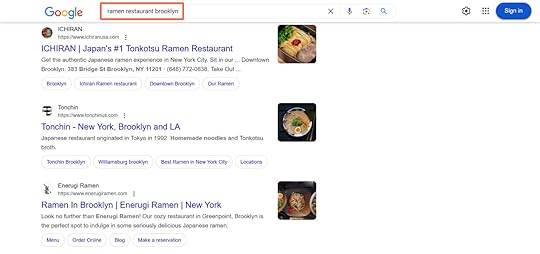
Besides restaurant themes, you can supercharge your WordPress website with plugins for adding menus, taking reservations, or displaying reviews.
On Premium plans and above, the OpenTable block can add a reservation widget anywhere on your site. In addition, you can use the Map block for displaying your location(s).
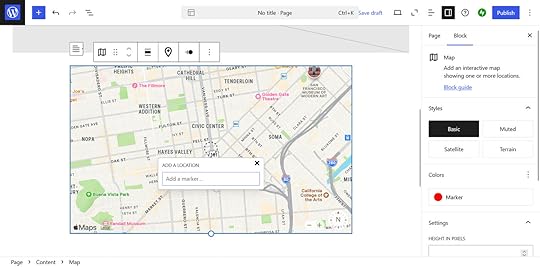
See our guide on building a restaurant website for more tips.
13. One-page website/landing pageAs the name suggests, these types of websites show all their content on a single page. Doing so provides a focused and distraction-free viewing experience that is especially convenient for mobile users who often prefer scrolling over clicking.
One-page sites are also great for promoting a product, service, event, or special offer, and they’re popular for generating leads by collecting emails or phone numbers through forms.
To create your own, pick from the many one-page themes available on WordPress.com (or upload your favorite third-party theme on the Business plan and above).
 The CoachAva theme14. Real estate websites
The CoachAva theme14. Real estate websitesAs a real estate business, you definitely want a website to advertise your listings and attract potential buyers. A web presence allows you to display lots of information about your listings, including high-quality images, property descriptions, and pricing. You can even allow visitors to filter your listings by property type, location, and budget.
Most importantly, your website gives potential buyers or renters an easy way to contact you. On top of that, you can automate appointment booking for property viewings and use a blog to teach clients about the buying process and improve SEO.
To get started, pick a real estate theme like Rivington.
 The Rivington theme
The Rivington themeAfter that, extend your site with real estate plugins that can add valuable functionality like mortgage calculators to your site.
Community sitesOne of the best things about the internet is its ability to bring people together. If building community is your goal, these types of websites can help you make it happen.
15. Community websiteBuild a hub for people with a common goal or interest, such as neighborhood associations, membership-based organizations, or fan clubs. Community websites facilitate discussions, events, and knowledge-sharing.
With membership plugins, users can create profiles, join groups, and interact with one another. In addition, they let you provide exclusive content or resources to members and assign content moderators.
There are plenty of themes for community websites on WordPress.com. A great example is Cultivate.
 The Cultivate theme
The Cultivate themeAdding forums to your community website is also an option.
16. Forum websiteOnline forums can form around any topic, from fitness to technology to gardening and beyond.
A forum can become a rich knowledge base for niche topics or industries and provide a space for debates, troubleshooting, and helping one another. Memberships, ads, or premium content are all great ways to monetize your forum website.
Using WordPress plugins, you can easily add forum and discussion boards to your website. Two of the most well-known options are bbPress and BuddyPress.
Refer to our tutorial on how to build online forums for in-depth instructions.
17. Membership websiteWhile similar to what we’ve discussed already, membership sites allow you to offer exclusive content, courses, or services to your members—like articles, access to consulting, resources, videos, or downloads.
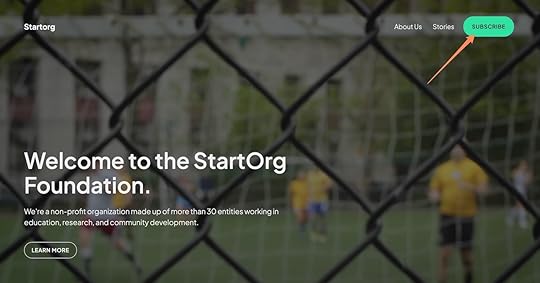 The StartOrg theme
The StartOrg themeYou can also set up tiers with different perks and include community tools like forums and chats. Membership sites are a particularly great business model to generate recurring revenue through subscriptions.
There are a variety of membership plugins you can use. Two of the most popular solutions are Members by MemberPress and Ultimate Member.
As a WordPress.com user, you can also take advantage of the Paid Content block to gate your content.
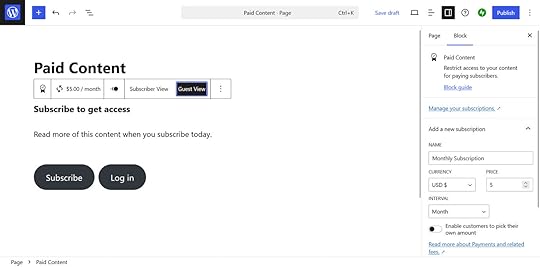
Finally, choose from themes that support membership sites.
Educational websitesEducational websites are a great way to teach new skills, share knowledge, or promote a learning institution—online and on your terms.
18. Online course websiteOnline courses can take different forms: all text, video, audio, or a mix of different media. They enable creators to share knowledge, generate income, and give customers ways to further their education.
On WordPress.com, you can create your own courses using learning management systems (LMS) like Sensei.
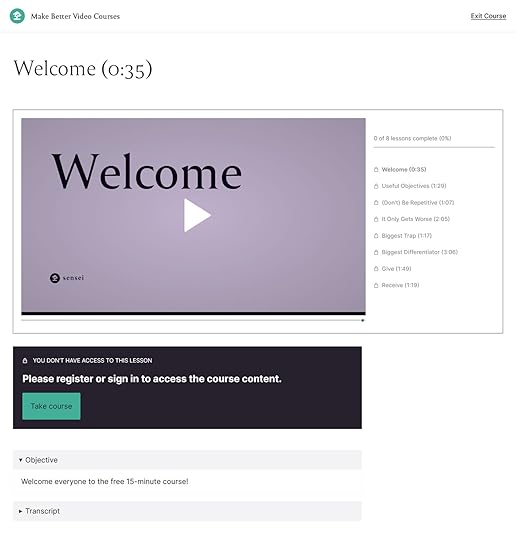
With LMS solutions, you can create lessons and quizzes inside WordPress and track student progress and performance. Sensei Pro also integrates with WooCommerce so you can sell your courses as products.
The Course theme was specifically designed to work with Sensei, but you can also choose another theme for online learning.
 The Course theme19. Wiki or knowledge base
The Course theme19. Wiki or knowledge baseThis type of website enables you to provide detailed information on a specific topic or industry. For example, you can create a centralized knowledge hub to help customers troubleshoot issues and find answers.
WordPress.com themes for wiki sites allow you to hit the ground running with a design that enhances the information in your knowledge base.
20. School/university websiteTraditional learning institutions need websites to provide essential information for students, parents, and faculty. You can also show off academic programs, admission processes, and campus life and offer online applications, registrations, e-learning portals, and online courses.
There are many themes for websites for educational institutions like Kentwood.
 The Kentwood theme
The Kentwood themeYou can also use the features mentioned above to add contact forms and membership areas.
Faith and cause websitesOur final category includes websites devoted to religious faith and meaningful causes, giving people a place to gather, share, and take action.
21. Crowdfunding websiteWith a crowdfunding website, you can create a financing source for projects worth supporting. A crowdfunding site brings together founders and backers, tracks donation goals and progress, and provides secure payment gateways for transactions.
If you want to build your own, themes for crowdfunding sites give you a great place to start. There are also several crowdfunding plugins you can find on WordPress.com, including Crowdfunding for WooCommerce.
Blocks like the Sharing Buttons block make it easy to spread information about your crowdfunding efforts on social media, and there are many email marketing integrations available to keep backers engaged and informed.
22. Nonprofit websiteNonprofits may also use websites to promote their work, build support, attract volunteers, and raise funds.
If you build your nonprofit website on WordPress.com, you have a range of suitable themes to choose from, including Timestream.
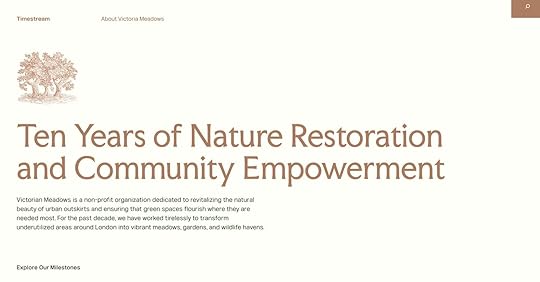 The Timestream theme
The Timestream themeUse the Donations block to accept contributions or a dedicated donation plugin like GiveWP. There are more plugin options for nonprofits, and we also have a guide to help you start a nonprofit website.
23. Charity websiteCharity websites and nonprofit sites are similar—their goals are alike, and they can benefit from many of the same website features. WordPress.com also offers specialized themes and plugins for them.
 The Alves theme24. Religious website
The Alves theme24. Religious websiteIf you’re part of a church, mosque, temple, or spiritual organization, you can use a website to appeal to current and future members. Share your message, projects, and information about services, study groups, and religious events online. You can also collect donations.
There are many WordPress.com themes for religious websites, too.
25. Political campaign websiteThese types of websites are useful for sharing your candidate’s platform, policies, and campaign promises. They help mobilize supporters and volunteers, accept donations, and provide contact options. Plus, you can share updates, press releases, and upcoming events through them.
On WordPress.com, you can use the Poll block to query followers on important issues, and the Event Countdown block creates anticipation for upcoming town halls or elections.
Use WordPress for all types of websitesIt should be clear by now that you can use WordPress to create nearly any kind of website. Its ease of use, wide range of blocks, and many themes and plugins make it flexible enough to fulfill any needs you have.
Keep in mind that it often makes sense to combine several website types to better monetize or publicize your work. For example, you could combine:
A blog, personal, or business website with an online shop.School websites with online courses.Magazine sites with membership sections.Whether you’re publishing posts, launching a product, or starting a movement, WordPress.com brings together what you need—hosting, domains, ecommerce, performance, and support—into one seamless platform that grows with you.
Build with WordPress.comMarch 25, 2025
46 Parts of a Website: From Header to Footer and Everything in Between
Ready to build your first website but confused by the technical lingo?
In this post, we’ll provide a glossary of terms you might encounter as you build a website. We recommend bookmarking this page for easy reference—like a pocket dictionary you can return to whenever you encounter an unfamiliar term.
We’ll focus on WordPress websites throughout, but most of the principles and definitions apply to websites built on any platform.
Technical parts of a websiteWebsite hostingDomainsURLs, permalinks, and slugs CDNXML sitemapContent management systems (CMS)Website codeHTMLCSSJavaScriptPHPWebsite metadataTitle tagsMeta descriptionsSchema markup Navigational elementsMenuLinksBreadcrumbsButtonsSharing buttonsHeaderFooterWebsite contentText and copyImagesVideoPage elementsHeadlineTaglineBody contentCommon website pagesHomepageProduct and service pagesAbout pageContact page404 error pageBlogPostsCategoriesTagsContact and content sharingContact formsNewsletter signup formsSocial media integrationsEcommerceCheckout cartsPayment processorsWordPress-specific website partsThemesPluginsPatternsBlocksBackupSecurityReaderBuild your website: Easy as ABCTechnical parts of a websiteEvery website requires a few key technical components. Understanding what each does can help you choose the right location for your site and evaluate different providers.
Website hostingYour site must be stored on physical servers through a website host. Hosting is essentially your site’s place of residence on the internet.
Managed hosting (like the hosting plans we have on WordPress.com!) is often an ideal choice for website owners because they take on an active role in running your website. In the case of WordPress.com, we take care of your server setup and the day-to-day management of your website, including security, uptime, and software updates, all for one flat price.
Get managed hostingDomainsA is a website’s address, like mygroovywebsite.com. Like physical addresses, every website must have a unique domain name.
Domain prices vary depending on the web extension (like .com, .net, .org) and which domain provider you choose, and you can use a domain lookup tool to see what domains are currently available.
WordPress.com offers affordable domains with over 350 different domain extensions and averaging just $13/year!
Buy a domainURLs, permalinks, and slugsSimilar to domains, URLs are the specific page addresses for your web pages. URLs are a version of your domain with added information that tells your computer which page to load.
So if a website’s homepage is mygroovywebsite.com, subpages have additional path information, like mygroovywebsite.com/about, which would load the website’s about page.
Permalinks are permanent URLs that point to a specific piece of content (you can update your default permalink structure on a WordPress site with just a few clicks), while slugs are part of the URL that identifies a specific page (like “about” in our example above).
CDNA content delivery network, or CDN, hosts your website on a system of distributed servers instead of one individual server. By utilizing location-specific servers, a CDN improves site speed by delivering content from a server that’s geographically closer to your visitors. Multiple servers also create redundancy, ensuring your site works even when you have a lot of visitors or if a server goes down.
All WordPress.com plans have a CDN, powered by 28+ data centers across 6 continents, that puts your content as close to your visitors as possible.
XML sitemapAn XML sitemap is a list of all of the crawlable URLs on your website so that search engines (like Google) can index and show them in search results. A sitemap helps search engines better understand your site’s structure and how your content is related.
Content management systems (CMS)A CMS is a tool that helps you build and manage a website without needing to code it from scratch. It provides a user-friendly interface to make it easy to build pages, write posts, and share other content.
What is the most popular CMS in the world? WordPress!
Website code“Code” is a computer-readable direction written in programming languages. Even if you use a CMS like WordPress to build your site, there’s still a bunch of code running behind the scenes to make everything work and run smoothly. There are many programming languages, but some that you’ll most commonly see when working with WordPress are HTML, CSS, JavaScript, and PHP.
HTMLHTML (HyperText Markup Language) defines the content structure of your website. Think of this as a computer-readable version of your website that includes all the page’s core content, including titles, text, lists, buttons, and images.
HTML uses “tags” to define each of these building blocks of your website, like for top-level headings and
for paragraphs.CSSCSS (Cascading Style Sheets) defines the style of your website. It is a design reference glossary for the browser, indicating what fonts, colors, sizes, and other elements to use when displaying your website. The cool thing about CSS is that your site updates automatically everywhere when you change a style in your glossary.
For example, if you have an primary header tag in your HTML, the computer will look to the CSS to see what headers should look like. The CSS might define an as Arial font, bolded, and 36 pixels. Anywhere that the computer sees the on your website, it will show that text in Arial font, bolded, and 36 pixels.
JavaScriptJavaScript controls the interactive elements of your website that move or change on your otherwise static web pages. JavaScript runs on the user’s side to create animations, popups, banners, alerts, and more.
For example, you might use JavaScript to alert users if they didn’t properly fill out a form or to change the screen once they submit it to show them that their response has been received.
PHPPHP (Hypertext Preprocessor) is similar to JavaScript in that it “makes things happen” in real-time on your website. One big difference with PHP is that it runs “server-side,” meaning it changes data or dynamically updates a page’s content before it loads for visitors.
PHP is an open source programming language and the language that powers the WordPress software.
Website metadataMetadata helps search engines identify what kind of content is on your website. This allows search engines to know when your website is relevant to someone searching the web for specific information.
Title tagsA title tag is an HTML element used by both search engines and visitors to understand what your webpage is about. Usually, this is the same as the post or page’s headline or title.
Meta descriptionsMeta descriptions are short paragraphs (ideally 120 to 160 characters) that offer additional information to engines about your content. These often include important keywords and phrases.
These descriptions may appear in search engine results, so it’s important to write strong, clear descriptions to make your website shine.
 Schema markup
Schema markup Schema markup is computer-readable information added to your site’s code to identify different types of content on your webpage. This helps search engines better understand your site’s purpose. Schema markup improves site SEO, contributing important information for search engine snippets and AI-powered search results.
For example, recipe plugins provide search engines with this kind of markup, enabling them to showcase recipes in search results with extra details such as images, ingredients, and cook times.
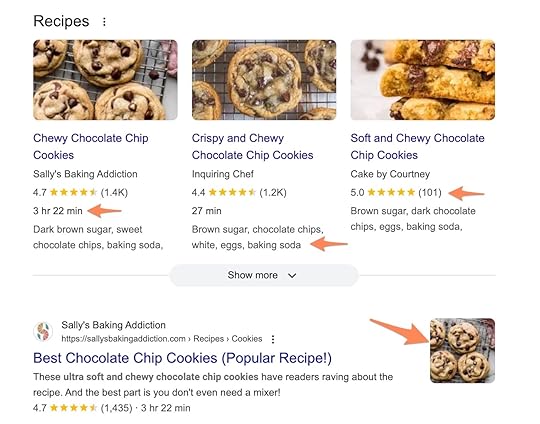 Navigational elements
Navigational elementsYour website’s navigation elements define how site visitors move across your website. You will likely use a variety of navigation elements across your site to meet the specific goals of each page.
MenuYour menu is the primary navigation tool for your website, linking to its high-level sections. Menu options may vary depending on your template, including primary navigation menus in your header and footer, sidebar menus from specific pages, and dropdown submenus.
“Hamburger menus” are common on mobile views, where detailed headers can take up too much space. These menus are hidden inside a button instead of always being visible in the header.
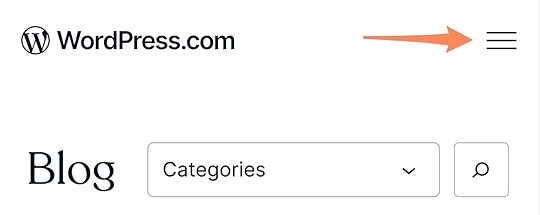 Links
LinksLinks are clickable text that take the site visitor to another page. They may direct users to another page on your site (internal links) or an external website (external links).
They also help search engines better understand the importance of your site pages—when a page has many relevant links that allow users to navigate to it, search engines will understand that it is a valuable page on your site.
BreadcrumbsSite breadcrumbs show users the “path” they took to reach their current page. For example, on a blog, a user may go from Home > Category > Blog Post.
Breadcrumbs are useful on sites with many layers of interconnected pages like stores, forums, or Wikis.
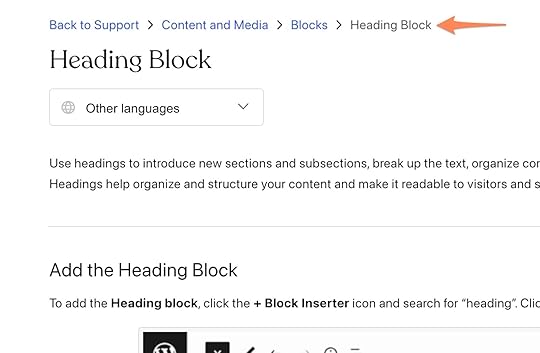 Buttons
ButtonsButtons are clickable visual elements that encourage users to take a specific action or navigate to a specific page. A site usually has three “levels” of buttons, with the primary buttons being the biggest and brightest, followed by secondary and tertiary buttons for less important navigation items.
Buttons should be strategically placed on your pages to nudge visitors to the most important content or action, such as your storefront or blog.
Sharing buttonsSharing buttons enable site visitors to easily share content from your website on other platforms, such as Facebook, Instagram, or Pinterest. They are a great way to promote your content cross-platform and build your following organically.
Sharing buttons are included for free on WordPress.com with Jetpack.
HeaderThe website header is the content at the top of every page. This section usually includes your logo, site name, tagline, and top-level site navigation (your menu!).
FooterThe footer is the bottom section of your site, visible below your content on every page. It can contain additional information such as website copyright, contact forms, newsletter subscription boxes, physical addresses, social media links, or lower-priority navigation items like your privacy policy or refund policy.
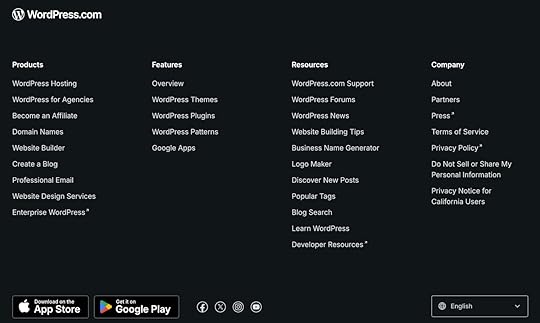 Website content
Website contentYour website content is what makes your website unique. Whether you are a blogger or a virtual store, your content helps you to create a personalized presence on the web.
Text and copyYour website’s text or copy is anything you write or customize, from menu labels to page titles, blog posts, about pages, and more.
Want to learn how to write truly excellent blog copy? Use this blueprint.
ImagesHigh-quality and relevant images are an essential part of any website. You can use your own high-quality images, license images through a stock image company, get free unlicensed imagery from sites like Pexels, or generate images with tools like Jetpack AI.
Check out our WordPress image size guide to ensure your images are optimized for the web.
VideoVideos are widely used on websites because they’re often more engaging than static images. If you have a WordPress site, you can use the YouTube block to easily embed YouTube-hosted videos on your posts or pages.
You can also upload your videos directly onto your site. WordPress.com offers 4K video hosting with VideoPress on the Premium plan and above.
Page elementsSandwiched between your header and footer is your main page. Regardless of the page content or layout, many pages have a few standard parts.
HeadlineYour headline, known in HTML lingo as the , describes what your page is about; this could be something short like “About” or more specific, like the title of your blog post.
You should only ever have one on a webpage.
TaglineA website tagline, similar to a brand tagline, is a short, memorable phrase that explains your site’s purpose. Site taglines are usually displayed in the site header next to or under the site title or logo, in search engine results, and in social media blocks.
Body contentThe body content is the meat of your webpage, located between the header and footer. It is specific to each page and includes all of its content elements, such as text, images, and videos.
WordPress makes it incredibly easy to add different kinds of content to your posts or pages with its block editor. There are many different blocks that come standard with any WordPress site, allowing you to customize your content exactly how you want.
Common website pagesWebsite pages can vary depending on your site’s purpose, but we recommend a few standard page types for every site.
HomepageYour homepage is the first page people will visit on your site, so it’s key that it is visually appealing, explains who you are and what you do, and directs visitors to other important pages across your site.
Product and service pagesBusinesses use product or service pages to explain their products and provide pricing. These pages vary in complexity, from simple text lists to full ecommerce stores.
Some product and service pages are purely informational; others are interactive, allowing users to purchase products directly from the page.
About pageAn about page tells your site’s story, whether you’re an individual or a business. This should cover who, what, and why—that is who you are, what you do, and why you do it.
You may include your personal or company history, awards or accolades, brand values, and individual or team biographies.
Contact pageYour contact page is where site visitors can find information on how to reach you, whether they want to schedule a meeting, contact you via email, or visit a physical location. This can be a simple text page or include forms, maps, and scheduling tools.
404 error pageA 404 error page alerts visitors if they are trying to visit a web URL that won’t load because the page they’re trying to access doesn’t exist. Users may see a 404 if they mistype a URL or try to access a page that you haven’t created on your site. For example, they may try to go to example.com/about-me when your about page URL is actually example.com/about.
You may want to optimize your 404 page to provide assistance to anyone who accidentally sees it with a search bar and links to helpful pages on your site.
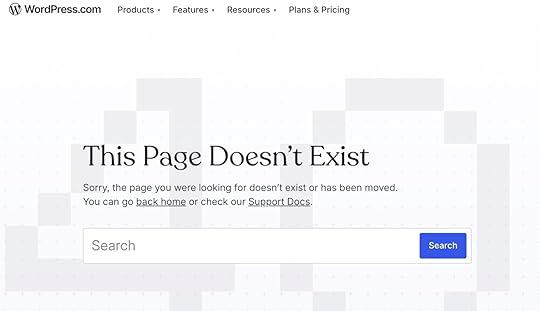 Blog
BlogFor many personal and professional websites, the blog is the heart of your site: this is where you will regularly create and post new content. Unlike standard web pages, a blog is designed for easy, ongoing publishing, engagement, and sharing.
Need to start a blog? Check out our 12-step guide.
PostsA post is a piece of content on your blog. Posts can include text, photos, and videos, but they also have unique elements like status, publish date, author, tags, and categories. These elements enable better navigation, search, and sorting.
Posts can be structured in many different ways, but there are a few common types of posts, including lists, how-tos, personal stories, case studies, features, interviews, product reviews, and news articles.
CategoriesCategories help you catalog and sort your blog posts. Categories split your content into a few high-level buckets. Categories should be broad enough to organize all of your posts but specific enough to be meaningful to your readers.
Category pages serve as an archive for all content grouped together under a specific category.
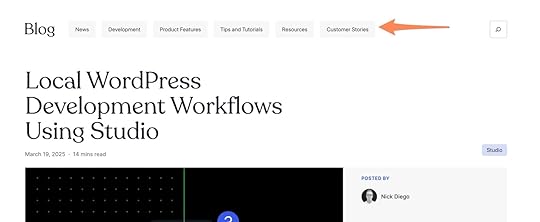 Tags
TagsSimilarly, tags group posts together, but they’re more specific ways to describe your content. For example, you may have a “Movies” category and “Adventure,” “Rom-Com,” “Horror,” and “Sci-Fi” tags.
You can use multiple tags on a single post, but to avoid clutter and to ensure your tags are useful for finding relevant content, you should only add tags for keywords that recur frequently across your website.
 Contact and content sharing
Contact and content sharingThere are a variety of reasons people may want to reach out to you through your website. Contact information—whether it’s a public email address, physical address, or form—is an important aspect of any website.
You’ll also want to ensure that you have ways for visitors to stay in the loop with what you’re up to. Whether you’re sending out a regular newsletter to your subscribers or sharing your content on social media, content sharing is a key component of a sustainable brand.
Contact formsContact forms allow website owners to receive messages—like questions, service requests, or feedback—without sharing their email addresses publicly. Visitors put their contact information and requests into a contact form, and the submitted form information is securely forwarded to an email address of your choosing.
There are many contact form plugins available, and the Form block is free to use for WordPress.com users with Jetpack.
Newsletter signup formsNewsletter signup forms allow site visitors to sign up for your newsletter. These forms have inputs for a visitor’s email address and sometimes their name, and then this information is added to your mailing list.
Subscribe blocks are available out-of-the-box for sites hosted on WordPress.com. Plugins are also available for third-party newsletter providers.
Social media integrationsSocial media integrations allow you to connect your blog to your social media platforms. Once these integrations are in place, you can easily pass content back and forth between your website and your social media platforms, posting directly from your blog to your social media sites or embedding your social media feeds directly on your website.
EcommerceAn ecommerce website sells goods or services online. WooCommerce, an open source plugin, is a sister company to WordPress.com. This plugin adds key ecommerce features like product pages, shopping carts, and payment processing to your site.
Checkout cartsCheckout carts are virtual shopping carts that allow visitors to select or save products they want to buy in one place. Checkout carts enable users to keep track of their items and buy multiple products in one transaction.
Payment processorsIn order for site visitors to be able to make a payment online, you need to use a payment processing software to securely accept credit card information and finalize payments.
For sites hosted on WordPress.com, you can easily collect payments through Stripe, the Paid Content block, and PayPal.
WordPress-specific website partsWordPress websites have their own internal language for different aspects of your site. If you use WordPress as your CMS or WordPress.com for hosting, these terms will help you better understand the tool and all that’s possible with it.
ThemesWordPress themes are professionally designed templates that you can install and customize. Themes make it simple to start with a base design you really love to then make your own with fonts, colors, images, text, and layouts.
WordPress.com has many different themes available to suit every website’s needs and visual style, including free themes and paid third-party themes. You can also install your own third-party themes on the Business plan and above.
 Plugins
PluginsPlugins are like apps for your website—they extend your site’s functionality and features. The WordPress plugin library offers free and paid plugins for security, SEO, marketing, forms, and more.

All WordPress.com users receive free essential functionality through the Jetpack plugin, with additional Jetpack features available at higher tiers. Third-party plugins can be added to sites on the Business plan and above.
PatternsPatterns are professionally designed page layouts for commonly used web pages, like about pages, photo galleries, storefronts, and contact pages. Patterns use a series of WordPress blocks to build eye-catching layouts that are easy to customize.
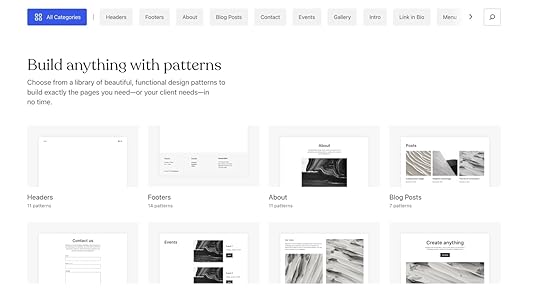 Blocks
BlocksBlocks (aptly named) are the building blocks of your WordPress website. Blocks are drag-and-drop elements that you can add to any post or page. There are around a hundred unique block types available for text, media, formatting, embedded content, theme-specific designs, forms, and more, with new block types added regularly.
With WordPress.com, you get even more with Jetpack-enabled block types.
BackupSite backups save previous versions of your website so that you can easily revert your site if something breaks. This can be useful when adding or updating plugins or updating your WordPress version or theme. WordPress.com offers backups with VaultPress on the Business plan and above.
SecurityWeb security is essential to ensure that both your data and your visitors’ data are protected. Security features include general site security to verify your website and block phishing or spam attacks, user-based permissions, and domain privacy to protect your personal data.
One benefit of using a managed hosting provider like WordPress.com is that many core security features—like automatic updates, SSL certificates, firewall protection, brute force attack prevention, downtime monitoring, and vulnerability scanning—come included, providing peace of mind for non-technical professionals.
ReaderThe Reader is an aggregator from WordPress.com that compiles content from Jetpack-enabled WordPress sites. Your Reader feed will show every post from the blogs you follow in one place. You can also explore new blogs or be discovered by other readers in searches that utilize categories and tags.
Build your website: Easy as ABCIf you’ve read through this entire post, congratulations! You’re essentially a web development linguist. If you’re still looking to get oriented, WordPress.com has tons of additional resources for website builders on our blog, guides, and forums.
WordPress.com is built to support website owners of all levels, so you can feel confident that we’ve got your back as you dive into the exciting world of building your own website. Get started with WordPress.com today:
Build your site on WordPress.comMarch 21, 2025
What is a Domain Name? A Beginner’s Guide to Website Domains
A domain name is what you type into your browser address bar to access a website. It usually consists of the name of the website or business and a domain extension like .com or .net.
Domains make the internet as we know it possible and are an important piece of your website’s overall branding. But you may be asking yourself:
How do domain names actually work? Why do they matter?How do I get one?We’ll answer all of that (and more) in this beginner’s guide to website domains.
What is a domain name?A domain name (or simply “domain”) is your website’s address on the web. google.com, wikipedia.com, and wordpress.com are all domains.
A domain can have many pages and URLs—such as https://wordpress.com/blog/—but the domain name itself is only the name plus its ending.

Besides hosting, domains are the second-most important element to make a website available online.
But did you know that domains are only placeholders? They are stand-ins for IP addresses, which look something like this: 192.0.2.1.
IP addresses are like home addresses for devices on a network, helping them find and communicate with each other. On the internet, this usually means a server—a computer that stores and shares websites so people can visit them.
In theory, you can also access a website if you know its server’s IP address, but those numbers are much harder to remember, and the IP address can also change over time. That’s why we use domain names—they’re a more human-friendly way to access information across the internet.
Domains work because of the Domain Name System or DNS—a network of specialized servers that function as the internet’s phone directory.
So when you type a domain name into your browser, here’s what’s actually happening:
Your browser asks a DNS service to find the website’s IP address.The DNS service looks it up and sends the IP address back.Your browser connects to that server and requests the website files.The server sends the files, and your browser displays the website.All of that happens automatically in the background and makes the web so much easier to use and explore.
What are domain names used for?While domains mostly exist to allow visitors to reach your site, they also fulfill other roles.
For one, a domain name gives you ownership. With your own domain, you can stake a claim on your part of the World Wide Web and display whatever you want at that location.
A domain name is also part of your site’s and company’s branding. It makes your website more recognizable and memorable. Your domain is what people will know you by and what differentiates you from the competition.
If the domain aligns with your business name and purpose, it provides consistency and reassures visitors that they are in the right place when they’re looking for information about you, your company, or your products.
Besides that, a domain name often describes what your website is offering, what it is about, and where it’s located. For example, if you see a domain name like gluten-free-gutenberg.com, you can safely guess that its content will have something to do with gluten free foods, cooking, or recipes. The website learntocodewith.me is another example where the domain name sets clear expectations for the intended audience.
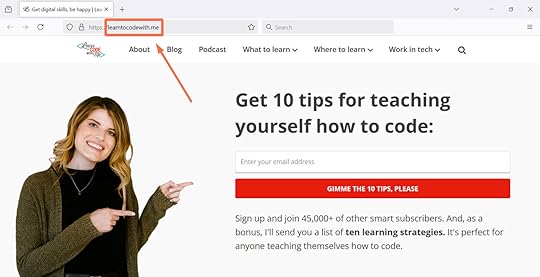
Finally, having your own domain name is an important sign of credibility. Customers take a business with its own domain more seriously than one using a subdomain of another service. This establishes trust and makes it more likely that visitors will use your site and do business with you.
It’s like the difference between using a Gmail address as your corporate email address and one with your business name in it—one simply appears more legitimate.
Plus, once you have your own domain name, you can use it in your email address and send branded messages.
What’s the difference between a domain name and a URL?A URL or “Uniform Resource Locator” often includes a domain but can have many more elements. Have a look at this example:
https://wordpress.com/blog/2025/01/29...
Let’s break down each element, the domain being only a small part of the full URL:
Let’s break down each element, the domain being only a small part of the full URL:
Protocol: https://Domain: wordpress.comPath: /blog/2025/01/29/how-to-make-a-websiteHTML anchor: #give-your-website-a-voiceURLs can contain even more components, and you can read Mozilla’s guide to URLs for details.
What are the parts of a domain name?So you understand parts of a URL, but how about parts of a domain?
Domains consist of several components, typically separated by periods. They range from general to more specific identifiers.
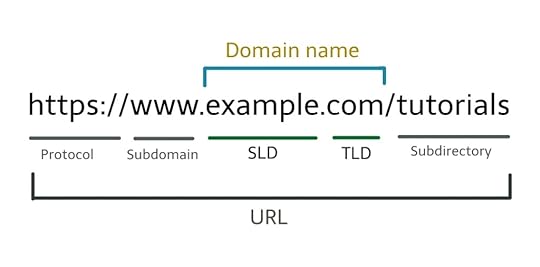
Let’s discuss each part in detail:
Top-level domainThe top-level domain (TLD) is commonly referred to as the domain name extension. In the case of wordpress.com, the TLD is .com.
It’s one of the most important parts of a site’s domain because it can tell a lot about a website. For example, .com points to commercial sites, and .org points to sites belonging to an organization.
Common domain endings are called “generic top-level domains” or gTLDs, but there are now hundreds to choose from. Some are industry-specific, like .agency, .pizza, .club, .design, .blog, or .business. They even exist for brands (e.g., .google), types of businesses (e.g., .realestate), and geographic locations (e.g., .nyc or .paris).
That said, .com is by far the most popular gTLD:
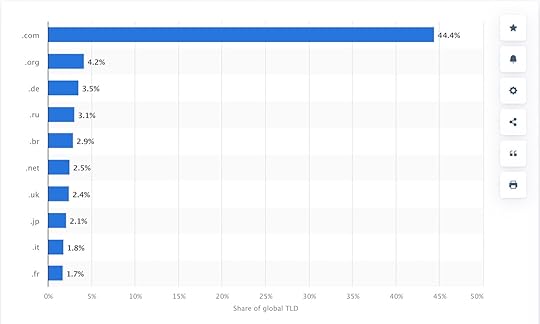 The popularity of TLDs from Statista.
The popularity of TLDs from Statista.There are also country code top-level domains (ccTLDs), such as .de for Germany, .mx for Mexico, or .se for Sweden. They signify which country a business or organization serves or resides in. Global brands also use ccTLD for a country-specific web presence.

Combinations of general and country-code top-level domains also exist, such as .co.uk and .com.au. Some TLDs have requirements for use, like requiring a specific language on the site.
Finally, some top-level domains are reserved for institutions like US government agencies (.gov), schools (.edu), or military organizations (.mil).
Tip: We offer over 350 top-level domains on WordPress.com! Find your new domain name here.
Second-level domainThe word or phrase to the left of the TLD is called a second-level domain (or SLD). The SLD usually contains your brand name and is the first point of association potential visitors have with your brand or blog’s name.
For example, if your domain name is open-sauce.store, visitors will probably expect to be able to buy sauces from an online or brick-and-mortar storefront.
Your SLD can have anywhere from one to sixty-three characters and can contain only the letters A through Z, digits 0 through 9, and the - character (which may not be first or last).
Picking a good name for your website is a science in itself, which is why we have a separate article on you can refer to for help.
Third-level domainAs you can probably guess, you have to go one step further to the left to find a third-level domain. Most of the time, if there is one, it will be a subdomain, the most common being www. You also frequently see third-level domains like developer.wordpress.com.
Tip: If you sign up for a free WordPress.com plan, your website will be located on a domain like example.wordpress.com.
There are also third-level domains, such as ftp or mail, that let you reach an FTP or email server. Some websites also use subdomains for different language versions of their site, like es.wikipedia.org.
All of that being said: You don’t have to have a third level to have a functional domain.
You could theoretically continue like this, and it is possible to create a 45th-level domain—but it’s very hard to imagine a use case for a domain name like that.
Who manages domain name registrations?Several organizations are in charge of organizing how domains are used.
At the top are the Internet Assigned Numbers Authority (IANA) and the Internet Corporation for Assigned Names and Numbers (ICANN). They are non-profit organizations that create and implement domain name policies.
Their job is to decide what domain endings are available and to maintain the technical infrastructure that makes the domain system possible.
That said, these organizations are not who you interact with when you want to get a domain name for yourself; you’d turn to a domain registrar instead.
Where can you get a domain name?Domain registrars are businesses that have contracts with ICANN and IANA and are allowed to register domains on their behalf. They also handle records and renewals, provide customer support, and transfer domains to other registrars.
There are many domain registrars, and WordPress.com is one of them! You can use our services to register your desired domain, even if you don’t host your website with us.
Here’s how to find your perfect domain name on WordPress.com:
Start by using our domain finder tool. Type in your desired domain name to check its availability and price. If the name you typed is already registered to someone else, the tool will make recommendations for alternative options.
If the name you typed is already registered to someone else, the tool will make recommendations for alternative options.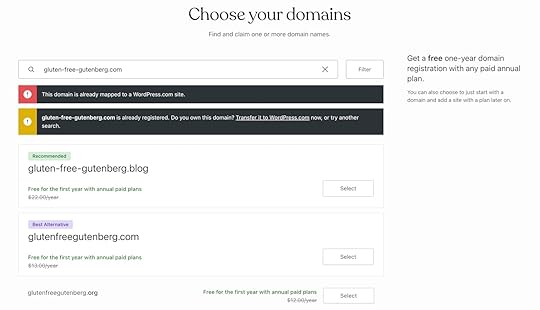 Once you choose a domain, simply add it to your shopping cart and go through the buying process.
Once you choose a domain, simply add it to your shopping cart and go through the buying process.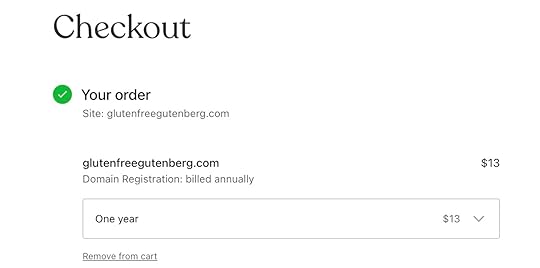
If you sign up for an annual hosting plan on WordPress.com, most domains are free for the first year.
Regardless of which WordPress.com hosting plan you choose to go along with your domain, you’ll love that everything—security, backups, performance, and support—is included for one price. There are no hidden fees or visitor limits; it’s just WordPress hosting done right.
How much do domains cost?Most domains cost less than $30 per year, and your domain payment will renew each year unless you cancel. The most commonly used extensions—like .com, .net, and .org—average just $13 per year on WordPress.com.
How can you keep your domain name secure?Since a domain name carries a lot of business value, keeping it secure is an absolute priority. Ensure you’re setting yourself up for success as you choose your new domain by:
Selecting a reputable registrar, such as WordPress.com.Keeping your contact information and personal details for the registered domain as private as possible. At WordPress.com, your domain comes with free privacy protection.Never sharing your domain registration login information.Watching out for phishing emails requesting login credentials. Most domain registrars never ask for this information.Enabling two-factor authentication, ensuring that a code is sent to you via phone or email for additional login protection.One final thing to remember is that if your domain payment doesn’t renew, your access to it will expire.
You can’t own a domain forever (but you can buy one for the next 100 years). When you purchase a domain, you acquire the exclusive usage rights to use it for a certain period of time. Extending your registration is possible as long as you want, but if you ever let it expire, your domain will go back on the market.
To prevent that from happening by accident:
Set your domain to renew automatically.Ensure your payment information is up to date.Keep your current email address on file so you don’t miss email notices from your domain registrar about expiring domains.If you accidentally let your domain expire, registrars are obliged to offer a grace period of at least 30 days to allow you to recover it before it is offered for sale to a new owner.
Final thoughts on domainsA domain is a core part of owning a website. It represents your site and business and gives you a slice of the internet where others can find and interact with you.
For that reason, take your time to decide on your domain name. Once you are ready to claim it, make sure you go with a domain registrar you trust. We’d be happy to help you register your domain name today.
Register a domain


